
Salvia officinalis is an aromatic, rather woody perennial shrub in the mint family (Lamiaceae) native to the shores of the northern Mediterranean. Its common names include culinary sage, common garden sage, or garden sage. The word “sage” has come to mean “wise” or “a wise or learned person.” It’s scientific name, Salvia, means “to be in good health”, “to save”, or “salvation” while officinalis is an old reference to an herb store, pharmacy, or drugstore.
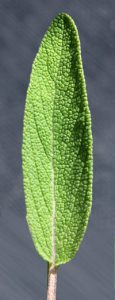
Sage is often mentioned as the herb of immortality, domestic virtue, health, and wisdom. Sage was a sacred ceremonial herb of the Romans. It has been cultivated for both culinary and medicinal purposes for many centuries in Europe. It is hardy in zones 4-10.
The species can grow to 2½ feet tall but many cultivars are much shorter. The opposite leaves vary in color from gray to gray-green, or may be purple or golden. They are are pebbly, slightly fuzzy, and up to 5″ long. The stems are green at first but become woody in the second year. It tends to be a short-lived perennial and is often best replaced every few years.
Common sage blooms in early summer. The camphor-scented, bluish-lavender to pink-lavender flowers are borne in whorls on short, upright flower spikes. Each flower has two lips. The flowers are attractive to bees and butterflies and occasionally to hummingbirds.
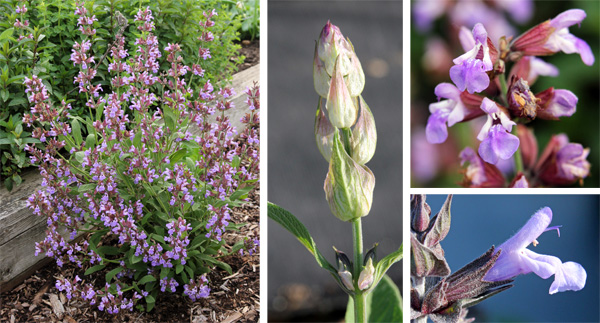
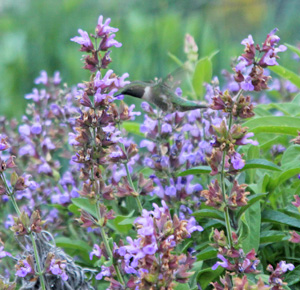
Sage’s soft-colored foliage and profusion of lovely purple-blue flower spikes blend beautifully into any herb garden. The gray leaves of the common varieties contrast nicely with the green of many other plants, so sage doesn’t have to be relegated to the herb or vegetable garden. It mixes well in perennial borders and in cottage gardens. Try planting sage in the border, especially intermixed with pink flowering plants. The smaller varieties can also be grown as container plants to be brought inside for a supply of fresh sage through the cold winter months.
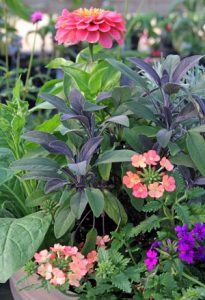
Sage grows best in a sunny location with well-drained soil. It will tolerate drought and poor soil fertility but will produce better with consistent water. Prune the plant in the spring and a few times through the growing season to encourage young shoots with a strong flavor and to prevent it from becoming leggy and twiggy (and going to flower which isn’t desired if using as a culinary herb). Space plants 18 to 24 inches apart and divide every couple of years to rejuvenate the plants.
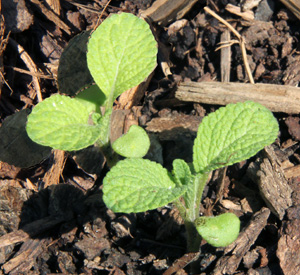
Sage is easy to start from seed (although most named varieties are not available as seed) and it can also be reproduced by layering, by division, or from stem cuttings. To grow from seed, either plant directly in the ground on the average date of last frost or start indoors 6 to 8 weeks before then. Either way the plant may not flower the first year. Layer established branches in the spring and fall, or divide large plants in the spring. Take softwood stem cuttings in summer and root in a sand-peat mixture.
Sage takes 75 days from planting to first harvest. At least twice during the growing season, cut 6-8″ from the top of the plants. Pick the leaves as desired as long as you don’t cut back more than half the plant or it will stop producing. Harvest before the plant flowers.
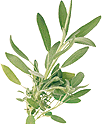 Sage has few pests when grown in well-drained soil. Good air circulation will reduce potential problems with foliar diseases. Some possible problems include slugs, spider mites, spittle bugs, root rot and wilt.
Sage has few pests when grown in well-drained soil. Good air circulation will reduce potential problems with foliar diseases. Some possible problems include slugs, spider mites, spittle bugs, root rot and wilt.

There are many different cultivars of sage which differ in leaf size, plant habit and leaf color. The purple or golden varieties make delightful ornamental houseplants. They’re smaller plants than the green or gray varieties but the flavor of the leaves is just as good. Some of the more commonly offered varieties include:
- Golden sage ‘Aurea’ – has chartreuse-yellow leaves enhanced by dark green areas around the veins. Only hardy to zone 6.
- ‘Berggarten’ – was discovered growing at the Berggarten Mansion in Germany. It has larger-than-average, gray-blue silvery, round leaves and a bushy habit that stays full down to the base of the stems. It is mildew resistant. Hardy to zone 5.
- ‘Icterina’ – has golden variegated leaves and is used mainly as an ornamental.
- ‘Compacta’ – has smaller leaves and more compact habit than regular sage, growing only 10 inches high, but with the same sage flavor. It is excellent for small areas, rockeries, and borders. It is propagated by cuttings only; seeds are unavailable.
- ‘Holt’s Mammoth’ – is similar to the standard variety but the leaves are larger.
- Purple sage (‘Purpurea’ or ‘Purpurascens’) – has purple leaves that are strongly flavored and grows 18 inches tall. It is also nice as an ornamental to complement yellow blossoms in the garden. Not as winter hardy as common sage (only to zone 6).
- ‘Tricolor’ – has green leaves edged in white and with rose streaks. It can be grown as a houseplant and is not as hardy as common sage (only to zone 6).
Besides these cultivars, there are many other closely related species of sage that can be used as herbs. Clary sage (S. sclarea) is a biennial or perennial with long spikes of white, purple, or blue flowers that can reach four feet high.
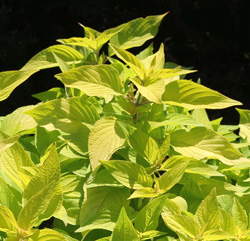
S. viridis is an ornamental annual sometimes sold as clary. It produces pink bracts that resemble flowers and make excellent cut or dried flowers but it has no herbal use. Pineapple sage (S. elegans) is an annual north of Zone 8 with pineapple-scented foliage and spikes of red flowers in late summer and fall. Its leaves can be used for teas and in fruit salads. Other related herbs include blue sage (S. clevelandii) and silver sage (S. argentea).

There are a multitude of uses for sage including culinary, medicinal, craft and ornamental. In the U.S. most people are familiar with sage in the stuffing for turkeys at Thanksgiving but it shouldn’t be restricted to this use. In other countries sage is used in a variety of sauces, especially with fatty meats. It is also commonly used in chicken or fish dishes, salads, or butters.
– Susan Mahr, University of Wisconsin – Madison





 Marigolds
Marigolds Create a Butterfly Garden
Create a Butterfly Garden Plant Flowers to Encourage Beneficial Insects
Plant Flowers to Encourage Beneficial Insects Forcing Bulbs
Forcing Bulbs


